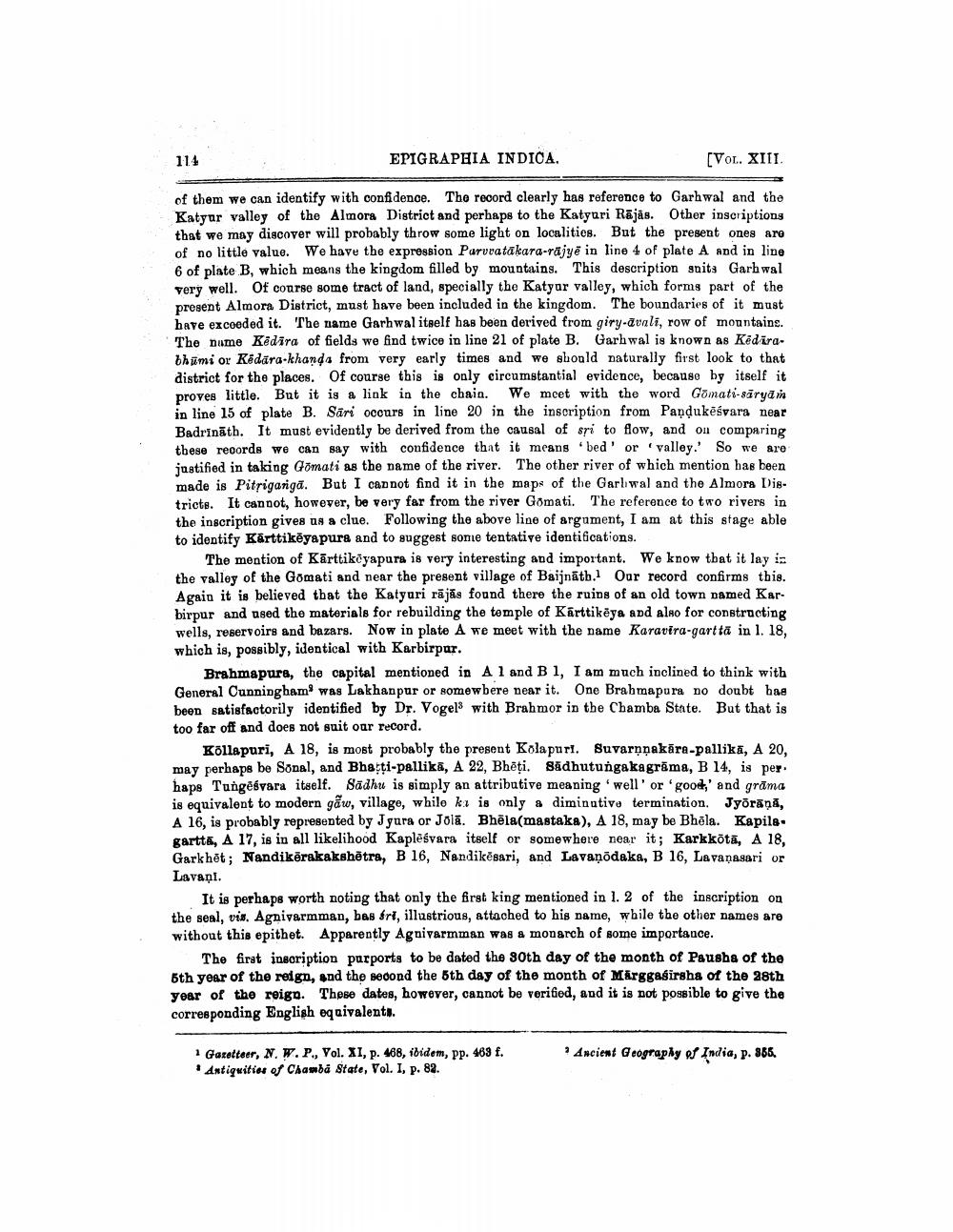________________
114
EPIGRAPHIA INDICA.
(VOL. XIII
of them we can identify with confidence. The record clearly has reference to Garhwal and the Katyar valley of the Almora District and perhaps to the Katyuri Rājās. Other inscriptions that we may discover will probably throw some light on localities. But the present ones are of no little value. We have the expression Parvratakara-rājyê in line 4 of plate A and in line 6 of plate B, which means the kingdom filled by mountains. This description snita Garhwal very well. Of course some tract of land, specially the Katyar valley, which forms part of the present Almora District, must have been included in the kingdom. The boundaries of it must have exceeded it. The name Garhwal itaelf has been derived from giry-dvali, row of mountains. The nume Kėdira of fields we find twice in line 21 of plate B. Garhwal is known as Kedirabhūmi or Rēdāra-khanda from very early times and we should naturally first look to that district for the places. Of course this is only circumstantial evidence, because by itself it proves little. But it is a link in the chain. We mcet with the word Gomati-särya in line 15 of plate B. Sari occurs in line 20 in the inscription from Pandukēśvara near Badrināth. It must evidently be derived from the causal of ssi to flow, and on comparing these records we can say with confidence that it means bed' or 'valley.' So we are justified in taking Gomati as the name of the river. The other river of which mention has been made is Pitrigariga. But I can not find it in the maps of the Garlwal and the Almora Districte. It cannot, however, be very far from the river Gomati. The reference to two rivers in the inscription gives us a clue. Following the above line of argument, I am at this stage able to identify Karttikēyapura and to suggest sone tentative identifications.
The mention of Karttiköyapura is very interesting and important. We know that it lay is the valley of the Gomati and near the present village of Baijnātb. Our record confirms this. Again it is believed that the Katyuri rājās found there the ruins of an old town named Karbirpur and used the materials for rebuilding the temple of Kärttikėya and also for constructing wells, reservoirs and bazars. Now in plate A we meet with the name Karavira-gartta in l. 18, which is, possibly, identical with Karbirpar.
Brahmapura, the capital mentioned in Al and B1, I am much inclined to think with General Cunningham was Lakhanpur or somewbere near it. One Brahmapura no doubt hae been satisfactorily identified by Dr. Vogels with Brahmor in the Chamba State. But that is too far off and does not suit our record.
Kollapuri, A 18, is most probably the present Kolapuri. Suvarnpakāra-pallika, A 20, may perhaps be Sonal, and Bhatti-pallika, A 22, Bhēţi. Sūdhutungakagrăma, B 14, is per haps Tungebyara itself. Sadhu is simply an attributive meaning 'well' or 'good,' and grāma is equivalent to modern găw, village, while k is only a diminutivo termination. Jyorānā, A 16, is probably represented by Jyura or Jolā. Bhēla(mastaka), A 18, may be Bhēla. Kapila. gartta, A 17, is in all likelihood Kapleśvara itself or somewhere near it; Karkkõtā, A 18, Garkhēt; Nandikërakakshētra, B 16, Nandikēsari, and Lavanodaka, B 16, Lavanagari or Lavani.
It is perhaps worth noting that only the first king mentioned in l. 2 of the inscription on the seal, vis. Agnivarmman, bas fri, illustrious, attached to his name, while the other names are without this epithet. Apparently Agnivarmman was a monarch of some importance.
The first inscription purports to be dated the 30th day of the month of Paushs of the 5th year of the reign, and the second the 5th day of the month of Marggasiraha of the 28th year of the reign. These dates, however, cannot be verified, and it is not possible to give the corresponding English equivalents.
1 Gazetteer, N. W. P., Vol. XI, p. 468, ibidem, pp. 463 f. * Antiquities of Chanba State, Vol. I, p. 82.
Ancient Geography of India, p. 866,




